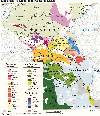| The Tsakhur (Caxur) people |
Azerb.com
|
 Of
the total 20.000 Tsakhur, about 15.000 live in northern Azerbaijan, on
and around Kas and Zaqatala. There they enjoy a mild climate, fertile soil
and good communications. The remaining live in the south-western part of
Dagestan, a harsh mountainous area with limited communications. The Tsakhur
call themselves 'Iiqhy', but are generally known by the name of their largest
villages, Tsakhur. From 1979 to 1989 the population grew by 48.8%!!
Of
the total 20.000 Tsakhur, about 15.000 live in northern Azerbaijan, on
and around Kas and Zaqatala. There they enjoy a mild climate, fertile soil
and good communications. The remaining live in the south-western part of
Dagestan, a harsh mountainous area with limited communications. The Tsakhur
call themselves 'Iiqhy', but are generally known by the name of their largest
villages, Tsakhur. From 1979 to 1989 the population grew by 48.8%!!
Originally the Tsakhur lived in Dagestan, but during the 13th century, some of them moved into Azerbaijan. Throughout the years, they have fought for independence from the Turks and the Persians. In the beginning of the 19th century, they looked to Russia for help and became part of the Russian empire. In the middle of the 19th century the Tsakhur of Dagestan were exiled to Azerbaijan, but returned to their homeland nine years later. However, others chose to remain in Azerbaijan.
Traditionally the Tsakhur of Azerbaijan were farmers, growing maize, barleycorn, wheat, rice and millet. They also raised cattle sheep and domestic fowl. Their income was supplemented through gardening, producing silk, and growing tobacco. In Soviet times the economy continued to grow, due to new technology.
The traditional Tsakhur diet consisted of meat, dairy products, and grain, supplemented by fruits and vegetables. Alcoholic drinks and tea were added in the beginning of the 20th century. Today, many traditional dishes are still prepared, and techniques for preserving fruits and vegetables and for making jams and pickles have improved.
The Tsakhur traditionally wove textiles from wool combined with silk threads. Other traditional crafts included the making of rugs, the knitting of woollen socks and footwear, and working in wood, leather and metal. In Soviet times, knitting and rug making were maintained as crafts.
The Tsakhur formerly belonged to 'tukhums', or family cluster with common male ancestors. Even though the importance of the tukhums is less today, it is still undesirable to marry a person from a less honoured family. Young Tsakhur choose their own marriage partners but still rely on the help of matchmakers. Weddings last two to five days and involve all relatives and villagers. The Tsakhur live in nuclear families, which consist of the father, the mother, and their unmarried children.
In the 1930's a Latin based alphabet was introduced to the Tsakhur. However this script was abandoned some years later, and the Tsakhur language was not used for writing for the remainder of the Soviet period. Azeri has always served as the language of instruction, and today, most Tsakhur are fluent in it. Recently the decision has been made to make Tsakhur a written language again.
The Tsakhur are 100% Muslim. In the 13th century, the city of Tsakhur was one of the main centres of Islam in southern Dagestan. The mosques were the centres of religious life and were erected on the central square. Mullahs served in the mosques and carried out various rituals. However, some ceremonies were related to pre-Islamic customs. These include performing the 'rites of spring' (Novruz), collecting of flowers, evoking the rain and performing certain wedding rituals. Traces of animism were also preserved: belief in the special power of stones, trees, fire, water, and spirits. In case of sickness or disease, the Tsakhur traditionally sought the aid of local healers, diviners and sorcerers; used magic; and went on pilgrimages to holy places. Today modern medicine is used, along with healing arts.
sources: multimap, bethany
| see also: Zaqatala, maps, people, history, summary, places, photos |
| A to Z of Azerbaijan / A dan Z ye Azerbaycan |
www.azerb.com
|